
In December 2020, the City consulted the public on two road safety improvement projects:
In June 2021, City Council approved the installation of bike lanes on Martin Grove Road south of Rathburn Road to 92 meters north of Burnhamthorpe Road. The proposal to install physical separation on Rathburn Road was referred back to Transportation Services for consideration at a future date.
The bike lanes will be installed on Martin Grove Road as part of planned reconstruction of the intersection of Martin Grove Road and Rathburn Road, following the completion of watermain replacement on Martin Grove Road.
In June 2021, City Council authorized the installation of bike lanes on Martin Grove Road from south of Rathburn Road to 92 meters north of Burnhamthorpe Road.
For information about the proposed cycling connections on Martin Grove Road from Eglinton Avenue West to Dundas Street West, visit the Martin Grove Cycling Connections web page.
A Virtual Public Meeting was held on December 7, 2020, to share information about the options for road safety improvements on Rathburn Road and Martin Grove Road and the options for realigning the watermain below Mimico Creek.
The Virtual Public Meeting included:
When the City of Toronto proposes new cycling infrastructure, local residents and the wider public are invited provide feedback on the designs. For this project 3,100 notices were delivered by Canada Post in the neighbourhood, over 100 people participated in the Virtual Public Meeting and comments were received from over 275 people through the online feedback survey and by phone and email.
Overall there was strong support for physical separation (cycle tracks) on Martin Grove Road and strong support for low profile barriers in the existing buffer on Rathburn Road. A number of important concerns were raised by residents, and these were considered by the project team in the development of the recommended designs.
A number of important issues were raised during the public consultation. The Consultation Summary report provides an extended summary of the feedback received during the comment period. Below are some of the most frequently mentioned concerns with responses.
The cost to install and maintain physical separation is not warranted, given the low volume of people cycling
Response: Current design guidelines recommend physical separation on streets with volumes exceeding 6,000 vehicles/day, which applies to both Rathburn Road and Martin Grove Road. Physical separation improves safety and comfort for people cycling; it also encourages less confident or more vulnerable road users to cycle more often.
Funds for the installation and maintenance of cycling infrastructure are allocated through the City’s annual budget process. The budget is approved by City Council.
Physical separation will impact the delivery of City services
Response: All City services, including solid waste removal, snow clearing and annual leaf removal, would continue to operate at the current level of service delivery. The City has different types of equipment that would be used to clear snow, leaves and debris from the bike lane.
Physical separation would create delays for people driving and increase traffic congestion
Response: With the recommended designs, the number and direction of general traffic lanes would not change. Gaps in the physical separation in front of driveways, at bus stops and at intersections would allow people driving to safely pass other vehicles. During annual leaf removal operations, people driving may experience minor delays.
‘No stopping’ regulation on Martin Grove Road would create inconveniences
Response: Vehicles that need to make deliveries or pick up/drop off passengers on Martin Grove Rd will need to stop in driveways or on side streets, as they do in other parts of the city where curbside stopping is not permitted.
Physically separated bike lanes on Martin Grove Rd would not reduce vehicle collisions or speeding
Response: The cycle tracks recommended for Martin Grove Road (Segment 1) would narrow vehicle travel lanes to approximately 3.0 metres. Research shows that reducing the width of lanes results in lower vehicle speed, which reduces the incidence of collisions.
Creating the perception of less driving space through the addition of objects in the roadway, such as physical separation, also has a similar effect on drivers’ speed.
The painted median and concrete islands on Martin Grove Road have reduced vehicle collisions and assist residents with driveway access
Response: The recommended design for Segment 1, has been revised. With the new design, cycle tracks would be installed from Rathburn Road to the curve in the road north of Donalbert Road. and the existing median and traffic islands would remain from Rathburn Road to Saralou Court.
South of Saralou Court the painted median and one traffic island would be removed because there is insufficient space in the road for both bike lanes and a median.
Over half of survey participants prefer physical separation (cycle tracks) in Segment 2, from Donalbert Road to Burnhamthorpe Road
Response: The recommended design for Segment 2 is separated bike lanes with a painted buffer. The curb-to-curb width of the road in Segment 2 limits the width of the painted buffer areas to 0.5 metres. Adding physical separation to a narrow buffer would create challenges for effective maintenance.
Bike lanes are not needed on Martin Grove Road, given low volume of people cycling
Response: The City’s approach to growing the cycling network is guided by several policy objectives, including the TransformTO Climate Change Action Plan, which has set a long-term goal for active transportation: 75% of trips under 5 km walked or cycled by 2050.
The proposed network in the City’s Cycling Network Plan was identified through a scoring process that considered several key factors such as proximity to transit stations and linking parts of the existing network, in addition to current and projected usage.
As the city’s network of safe, connected bikeways grows, so will the number of people who choose to cycle. The proposed bike lane on Martin Grove Rd would establish connections with existing cycling infrastructure on Rathburn Road, on Martin Grove Road north of Rathburn Road, and to local trails. Connection south of Burnhamthorpe Road to the Kipling Transit Hub is proposed and will be studied starting in 2021.
New separated bike lanes are being proposed at this time to coordinate installation with the planned watermain replacement on Martin Grove Road and the redesign of the intersection at Rathburn Road in 2021. This allows for more efficient contracts and reduced duration of construction.
The recommended designs were updated in response to feedback from the public.
Martin Grove Road, from Rathburn Road to Donalbert Road (Segment 1)
Martin Grove Road, from Donalbert Road to Burnhamthorpe Road (Segment 2)
Rathburn Road, from Martin Grove Road to The East Mall


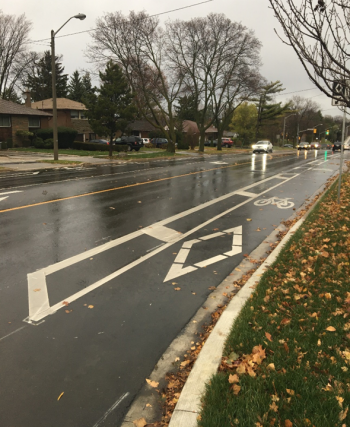
In 2020, painted buffers were added to the existing bike lanes on Rathburn Road from Martin Grove Road to approximately 100 metres east of The East Mall as part of road resurfacing work.
The City proposed the addition of physical separation to the existing buffered bike lanes on this section of Rathburn Road in 2021.
Physical separation was proposed to improve the safety and comfort of people cycling, to reduce speeding, and to encourage more people to cycle. Design guidelines and international best practice recommend physical separation between people cycling and people driving when traffic exceeds 6,000 vehicles/day. When physical separation is present, drivers are more cautious, vehicle speeds are lower, and people cycling feel safer. On this section of Rathburn Road, the volume of traffic is between 9,000 and 12,000 vehicles/day.
Two design options for physical separation on Rathburn Road were proposed. With both options, the City proposed to reduce the speed limit from 50 km/hr to 40 km/hr from The East Mall to Edenwood Drive.
Pre-cast concrete curbs with flexible posts (bollards)

Pre-cast low profile barriers with reflectors and hazard bollards

With both options:
View the proposed locations pre-cast concrete curbs (Option A) and proposed locations of pre-cast low profile barriers (Option B) presented during the consultation. If you need assistance with these files, please contact us.
The City proposed to install separated bike lanes on both sides of Martin Grove Road from Rathburn Road to approximately 100 metres north of Burnhamthorpe Road in 2022.

The Council-approved Cycling Network Plan outlines the City’s planned investments in cycling infrastructure from 2019 to 2021 and beyond. The plan identifies new cycling infrastructure on Martin Grove Road south of Rathburn Road. The bike lanes will establish one section of a future proposed bikeway connecting the existing bike lanes on Rathburn Road and the West Deane Trail with the future Kipling Transit Hub at Dundas St. West.
Two design options were considered for Martin Grove Road from Rathburn Road to 100 metres north of Burnhamthorpe Road.
With both options, the existing ‘No parking’ regulation on this segment of Martin Grove Road would become ‘No stopping’.
Both design options ensure that City services, including snow clearing and waste collection, will be maintained.
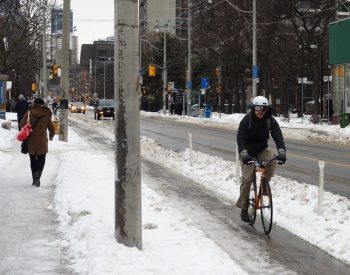

A number of key factors were considered in the development of the design options, including:
The design options for the segment of Martin Grove from Rathburn Road to Donalbert Road (Segment 1) were considered separately from the segment from Donalbert Road to 100 metres north of Burhamthorpe Road (Segment 2) because of differences in the width of the road.
With this option, the painted centre median and concrete traffic islands would be removed.
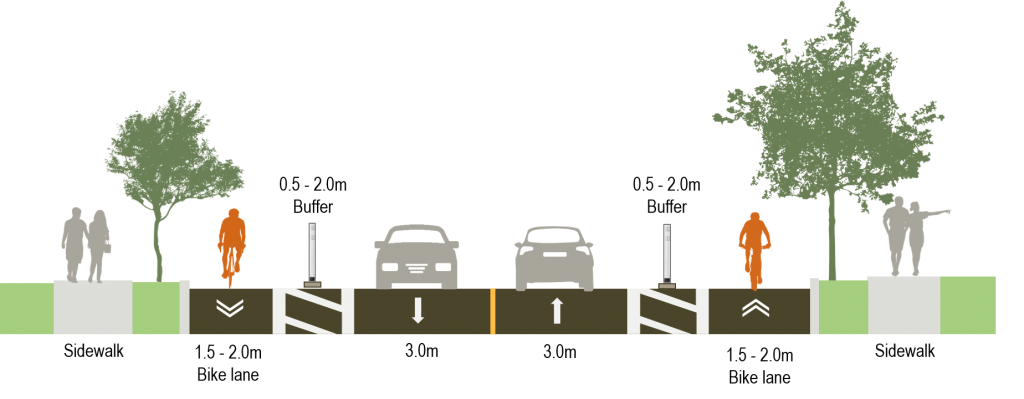
With this option, the painted centre median and three of the four concrete traffic islands would remain.
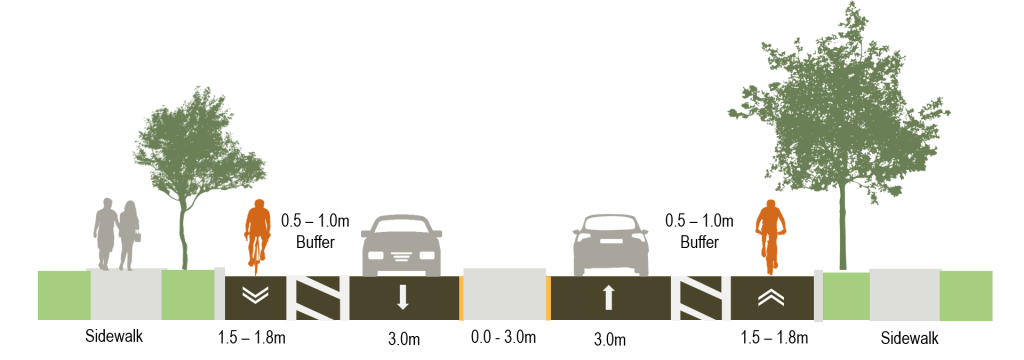
For Segment 1, Option A (cycle track) was the design preferred by City staff. It is anticipated to have greater traffic calming effects than Option B and would provide greater safety for people cycling.
View the original proposed plans for pavement markings and pre-cast concrete curbs with bollards for Segment 1:
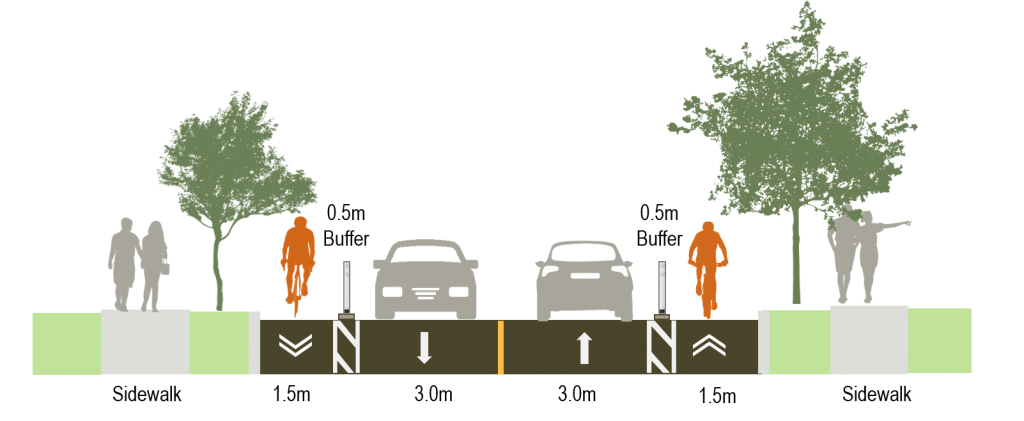
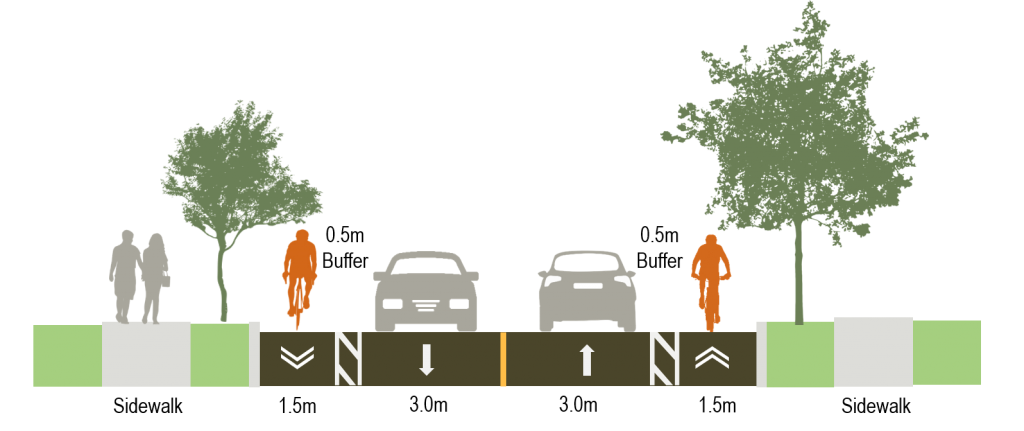
For Segment 2, Option B (buffered bike lane) was the design preferred by City staff because the proposed buffer would not be wide enough to easily accommodate snow storage. The curb-to-curb width of the road in Segment 2 would limit the width of the buffer to 0.5 metres.
View the original proposed drawings for pavement marking plan and pre-cast concrete curbs with bollards for Segment 2:

In 2017, a Transportation Safety Local Improvement Project (TSLIP) was programmed for the intersection of Martin Grove Road and Rathburn Road in response to a high number of motor vehicle collisions and resident concerns about speeding. In 2018, interim measures were put in place to improve road safety until more permanent improvements could be implemented. A portion of the southwest corner was painted out and flexible posts (bollards) were installed to adjust the radius of the corner, and a painted median and concrete traffic islands were installed on Martin Grove Road from Rathburn Road to Donalbert Road to narrow vehicle lanes and reduce speeding.
A new design for the intersection has been created that will maintain and enhance the traffic calming effects achieved by the temporary measures and increase the safety of road users, particularly the most vulnerable.
The planned changes include measures from the City’s Vision Zero Road Safety Plan, which aims to reduce traffic-related fatalities and serious injuries.
The new design will involve:
Reconstruction of the intersection is anticipated to begin after watermain replacement on Martin Grove Road is completed.